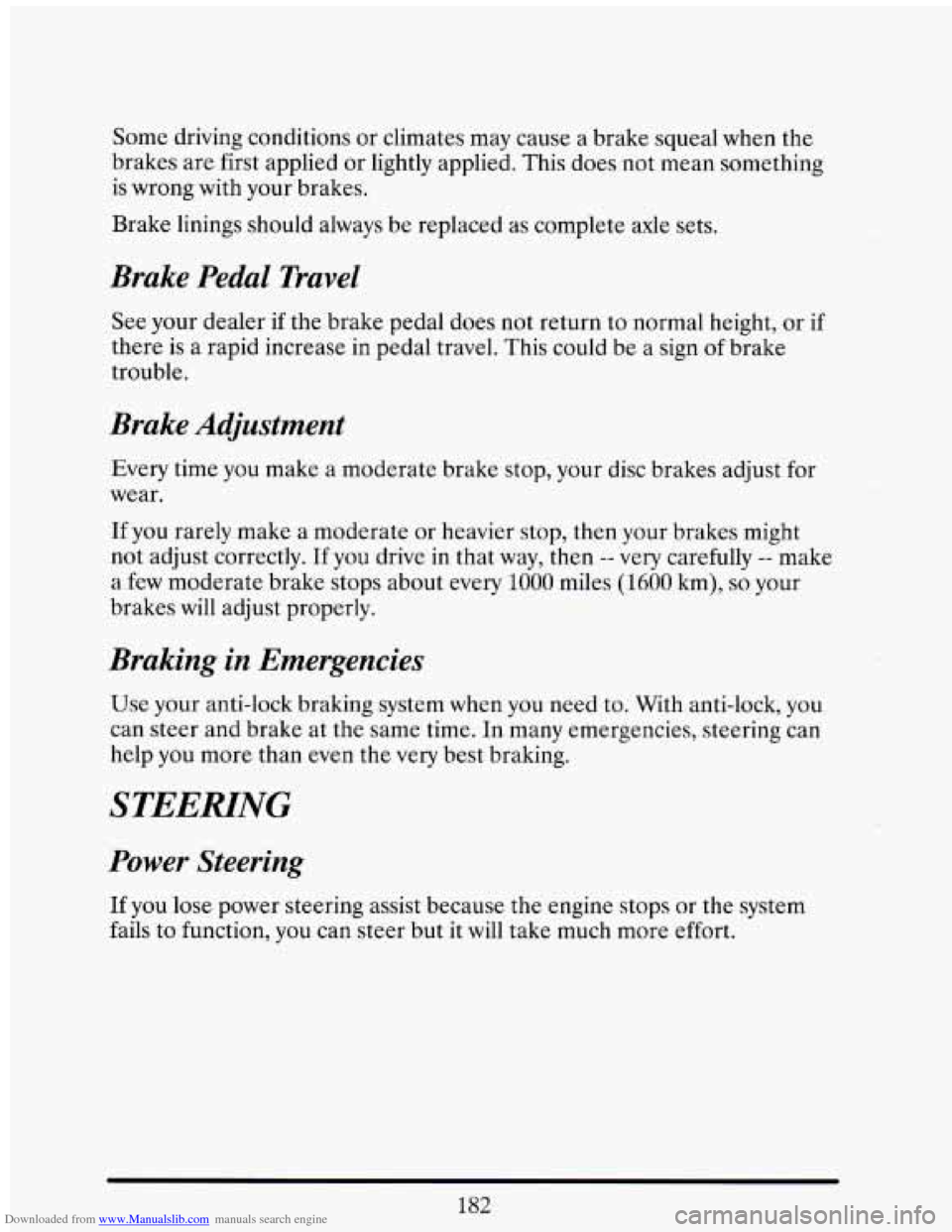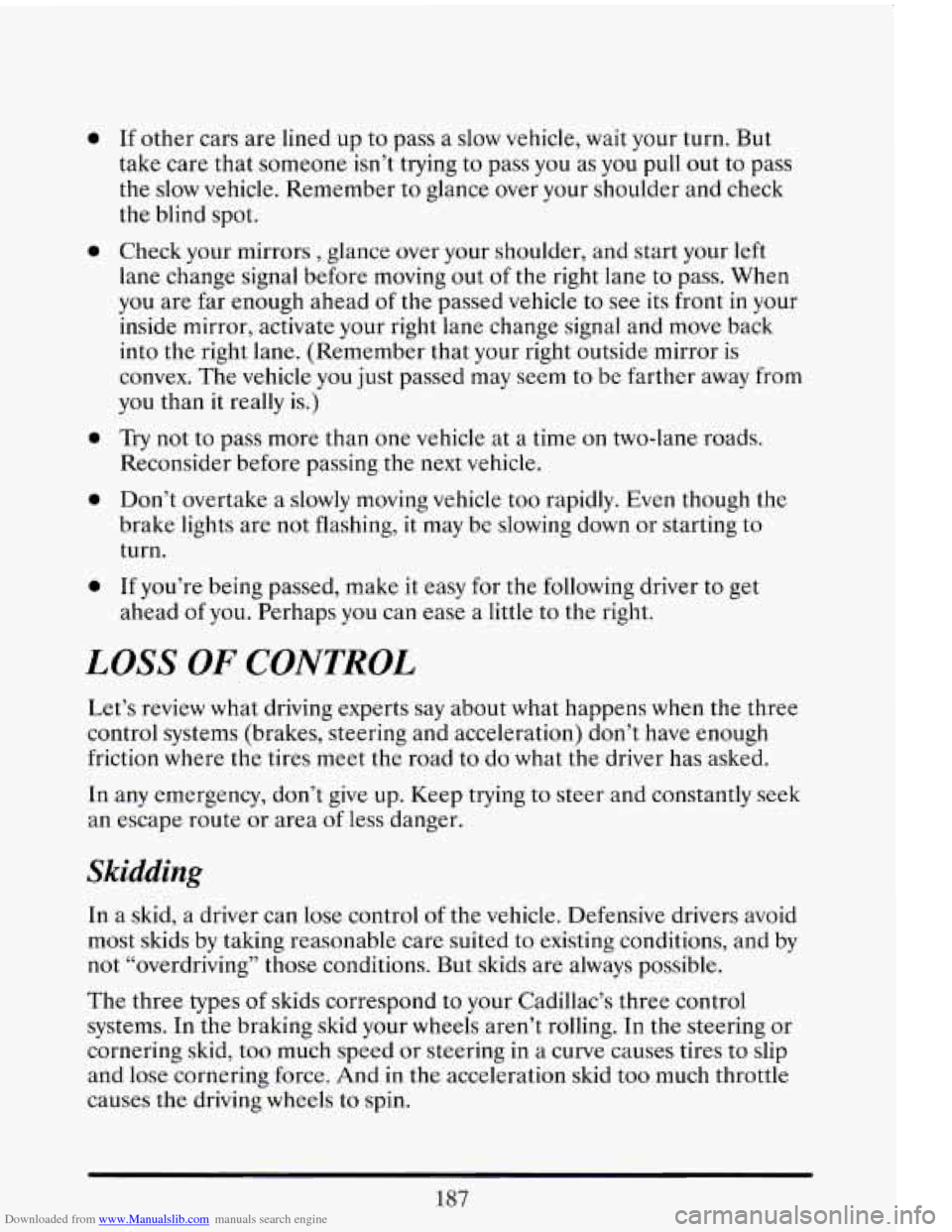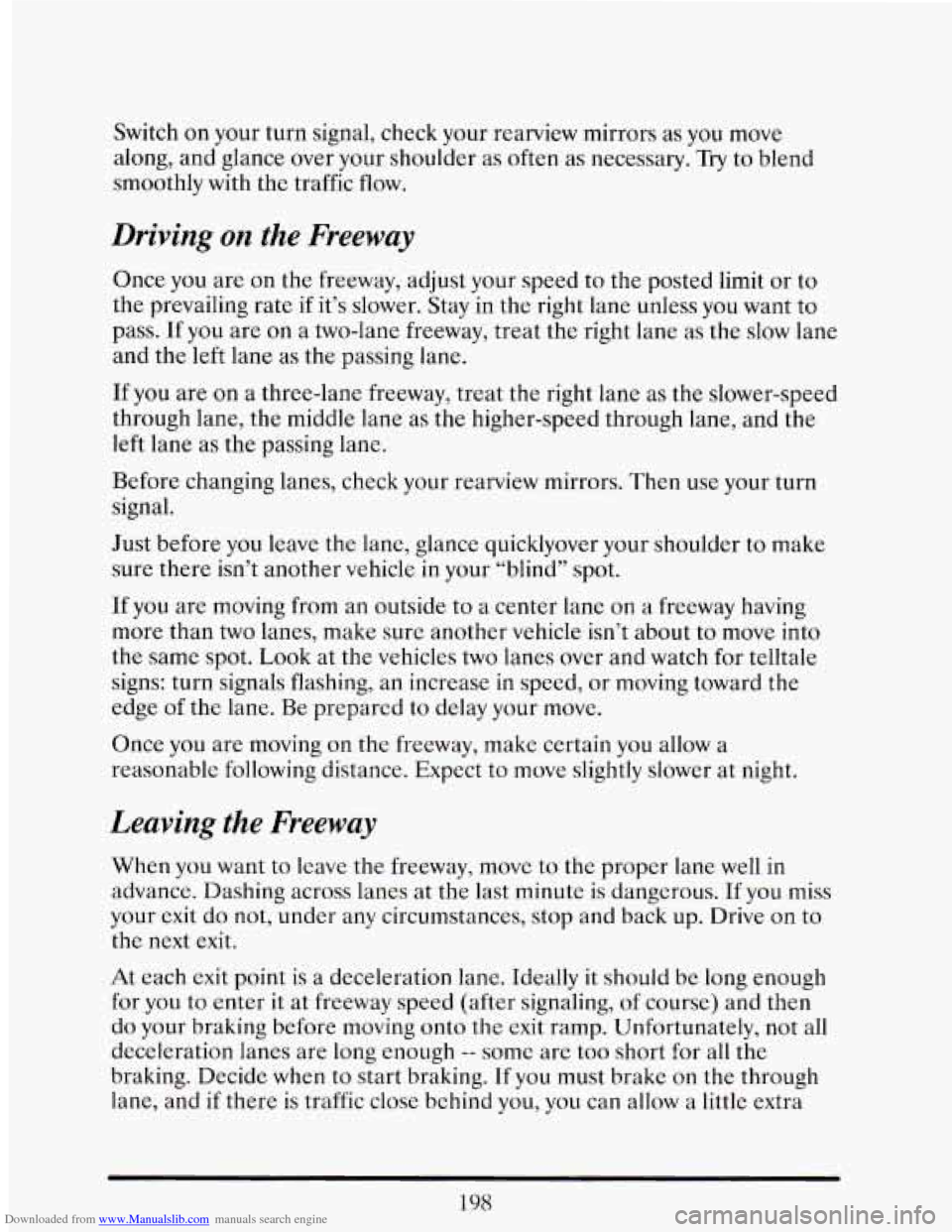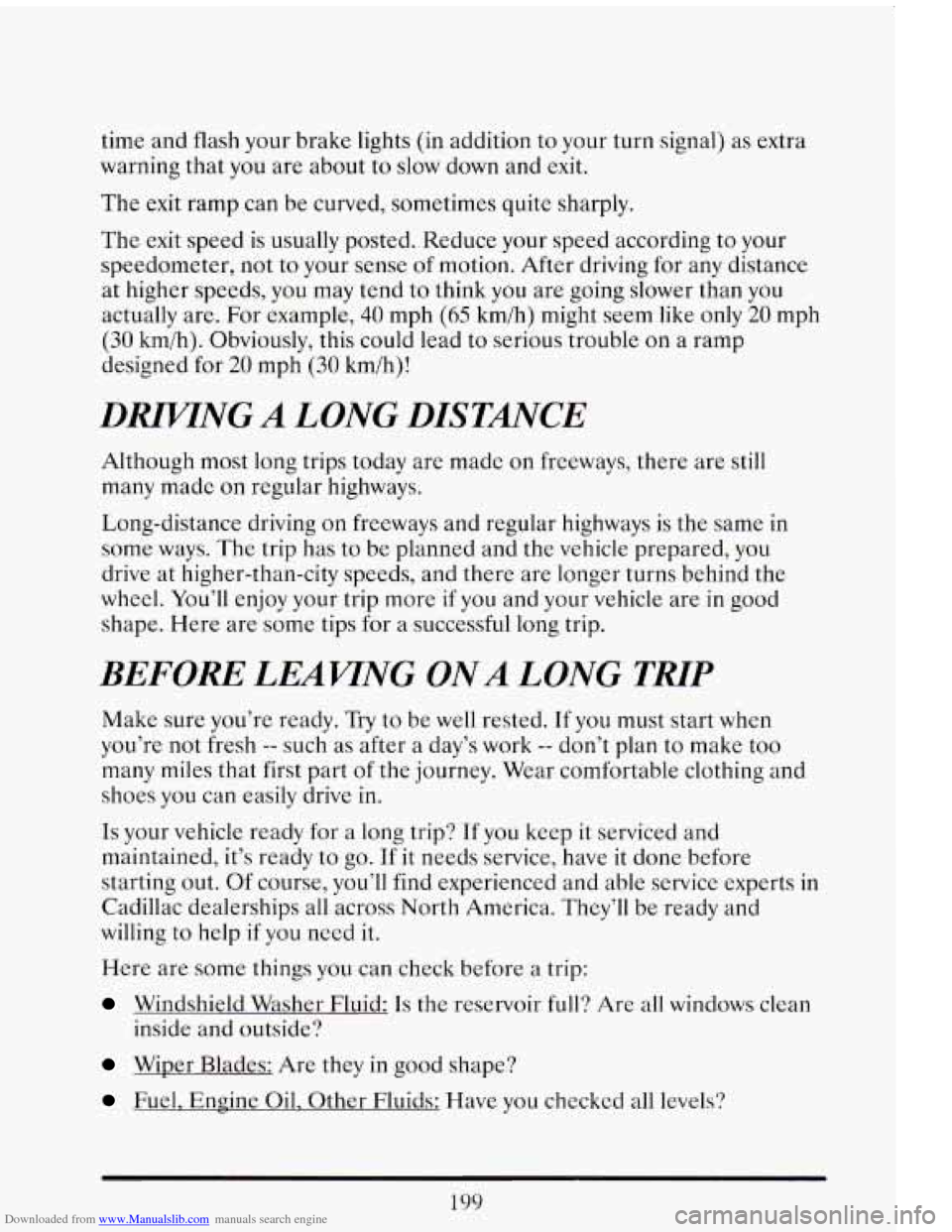1993 CADILLAC ELDORADO brake light
[x] Cancel search: brake lightPage 192 of 398

Downloaded from www.Manualslib.com manuals search engine with traffic. This is a mistake. Your brakes may not have time to cool
between hard stops. Your brakes will wear out much faster
if you do a
lot
of heavy braking. a
0 Don’t “ride’’ the brakes by letting your left foot rest lightly on the
brake pedal while driving.
8
r
. . ... ..
A CAUTION:
I
“Riding” your brakes can cause them to overheat to the point
that they won’t work well.
You might not be able to stop your
vehicle in time to avoid an accident.
If you “ride” your brakes,
they
will get so hot they will require a lot of pedal force to slc
you down. Avoid “riding” the brakes.
178
Page 193 of 398

Downloaded from www.Manualslib.com manuals search engine If you keep pace with the traffic and allow realistic following distances,
you
will eliminate a lot of unnecessary braking. That means better
braking and longer brake life.
If your engine ever stops while you’re driving, brake normally but
don’t pump your brakes.
If you do, the pedal may get harder to push
down.
If your engine. stops, you will still have some power brake assist.
But you
will use it when you brake. Once the power assist is used up, it
may take longer to stop and the brake pedal will be harder to push.
Anti-Lock Brakes (ABS)
Your Cadillac has an advanced electronic braking system that will help
prevent skidding.
This light on the
instrument panel
will
go on when you start
your vehicle.
hear a
Once the vehicle speed reaches about
5 mph (8 km/h), you may
momentary motor or c1,icking noise and you may
even notice that your
brake pedal moves a little
while this is going on. This is the ABS system
testing itself.
If there’s a problem with the anti-lock brake system, the
anti-lock brake system warning light will stay on. See “Anti-lock Brake
System Warning Light” in the Index.
179
Page 196 of 398

Downloaded from www.Manualslib.com manuals search engine Some driving conditions or climates may cause a brake squeal when the
brakes are first applied or lightly applied. This does not mean something
is wrong with your brakes.
Brake linings should always be replaced as complete axle sets.
Brake Pedal Travel
See your dealer if the brake pedal does not return to normal height, or if
there is a rapid increase in pedal travel. This could be a sign of brake
trouble.
Brake Adjustment
Every time you make a moderate brake stop, your disc brakes adjust for
wear.
If you rarely make a moderate or heavier stop, then your brakes might
not adjust correctly. If you drive
in that way, then -- very carefully -- make
a few moderate brake stops about every
1000 miles (1600 km), so your
brakes
will adjust properly.
Braking in Emergencies
Use your anti-lock braking system when you need to. With anti-lock, you
can steer and brake at the same time. In many emergencies, steering can
help you more than even the very best braking.
STEERING
Power Steering
If you lose power steering assist because the engine stops or the system
fails to function, you can steer but it
will take much more effort.
182
Page 201 of 398

Downloaded from www.Manualslib.com manuals search engine 0
a
0
a
0
If other cars are lined up to pass a slow vehicle, wait your turn. But
take care that someone isn’t trying to pass you as you pull out to pass
the slow vehicle. Remember to glance over your shoulder and check
the blind spot.
Check your mirrors
, glance over your shoulder, and start your left
lane change signal before moving out
of the right lane to pass. When
you are far enough ahead
of the passed vehicle to see its front in your
inside mirror, activate your right lane change signal and move back
into the right lane. (Remember that your right outside mirror is
convex. The vehicle
you just passed may seem to be farther away from
you than it really is.)
Try not to pass more than one vehicle at a time on two-lane roads.
Reconsider before passing the
next vehicle.
Don’t overtake
a slowly moving vehicle too rapidly. Even though the
brake lights are not flashing, it may be slowing down or starting to
turn.
If you’re being passed, make it easy for the following driver to get
ahead of you. Perhaps you can ease a little to the right.
LOSS OF CONTROL
Let’s review what driving experts say about what happens when the three
control systems (brakes, steering and acceleration) don’t have enough
friction where the tires meet the road to do what
the driver has asked.
In any emergency, don’t give up. Keep trying to steer and constantly seek
an escape route or area
of less danger.
Skidding
In a skid, a driver can lose control of the vehicle. Defensive drivers avoid
most skids by taking reasonable care suited to existing conditions, and
by
not “overdriving” those conditions. But skids are always possible.
The three types
of skids correspond to your Cadillac’s three control
systems. In the braking skid your wheels aren’t rolling. In the steering or
cornering skid, too much speed
or steering in a curve causes tires to slip
and
lose cornering force. And in the acceleration skid too much throttle
causes the driving wheels to spin.
Page 206 of 398

Downloaded from www.Manualslib.com manuals search engine I
Driving too fast through large water puddles or even going through some
car washes can cause problems, too. The water may affect your brakes.
Try to avoid puddles. But
if you can’t, try to slow down before you hit
them.
A CAUTION:
Wet brakes can cause accidents. They won’t work well in a quick
stop and may cause pulling
to one side. You could lose control of
the vehicle.
After driving through a large puddle
of water or a car wash,
apyiX7 your brake pedal lightly until yol’p brakes work normally.
Hydroplaning
Hydroplaning is dangerous. So much water can build up under your tires
that they can actually ride
on the water. This can happen if the road is wet
enough and you’re going fast enough. When your vehicle is hydroplaning,
it has little or no contact with the road.
You might not be aware
of hydroplaning. You could drive along for some
time without realizing your tires aren’t
in constant contact with the road.
192
Page 212 of 398

Downloaded from www.Manualslib.com manuals search engine Switch on your turn signal, check your rearview mirrors as you move
along, and glance over your shoulder as often as necessary.
Try to blend
smoothly with the traffic flow.
Driving on the Freeway
Once you are on the freeway, adjust your speed to the posted limit or to
the prevailing rate
if it’s slower. Stay in the right lane unless you want to
pass.
If you are on a two-lane freeway, treat the right lane as the slow lane
and the left lane as the passing lane.
If you are on
a three-lane freeway, treat the right lane as the slower-speed
through lane, the middle lane as the higher-speed through lane,\
and the left lane as the passing lane.
Before changing lanes, check your rearview mirrors. Then use your turn
signal.
Just before you leave the lane, glance quicklyover your shoulder to make
sure there isn’t another vehicle in your “blind” spot.
If you are moving from an outside to a center lane on a freeway having
more than two lanes, make sure another vehicle isn’t about to move into
the same spot. Look at the vehicles two lanes over and watch for telltale
signs: turn signals flashing, an increase
in speed, or moving toward the
edge
of the lane. Be prepared to delay your move.
Once you are moving on the freeway, make certain you allow
a
reasonable following distance. Expect to move slightly slower at night.
Leaving the Freeway
When you want to leave the freeway, move to the proper lane well in
advance. Dashing across lanes at the last minute
is dangerous. If you miss
your exit do not, under any circumstances, stop and back up. Drive on to
the next
exit.
At each exit point is a deceleration lane. Ideally it should be long enough
for you to enter it at freeway speed (after signaling,
of course) and then
do your braking before moving onto the exit ramp. Unfortunately, not all
deceleration lanes
are long enough -- some are too short for all the
braking. Decide when to start braking.
If you must brake on the through
lane, and if there is traffic close behind you, you can allow a little extra
Page 213 of 398

Downloaded from www.Manualslib.com manuals search engine time and flash your brake lights (in addition to your turn signal) as extra
warning that you are about
to slow down and exit.
The exit ramp can be curved, sometimes quite sharply.
The exit speed
is usually posted. Reduce your speed according to your
speedometer, not to your sense of motion. After driving for any distance
at higher speeds, you may tend to think you are going slower than you
actually are. For example,
40 mph (65 km/h) might seem like only 20 mph
(30 kmih). Obviously, this could lead to serious trouble on a ramp
designed for
20 mph (30 kmih)!
DMNG A LONG DISTANCE
Although most long trips today are made on freeways, there are still
many made on regular highways.
Long-distance driving on freeways and regular highways is the same in
some ways.
The trip has to be planned and the vehicle prepared, you
drive at higher-than-city speeds, and there are longer turns behind the
wheel. You’ll enjoy your trip more
if you and your vehicle are in good
shape. Here are some tips for a successful long trip.
BEFORE LEAVTNG ONA LONG TRIP
Make sure you’re ready. Try to be well rested. If you must start when
you’re not fresh
-- such as after a day’s work -- don’t plan to make too
many miles that first part
of the journey. Wear comfortable clothing and
shoes
you can easily drive in.
Is your vehicle ready for a long trip? If you keep it serviced and
maintained, it’s ready
to go. If it needs service, have it done before
starting out.
Of course, you’ll find experienced and able service experts in
Cadillac dealerships all across North America. They’ll be ready and
willing
to help if you need it.
Here are some things you can check before a trip:
Windshield Washer Fluid: Is the reservoir full? Are all windows clean
inside and outside?
Wiper Blades: Are they in good shape?
Fuel. Engine Oil, Other Fluids: Have you checked all levels‘?
199
Page 228 of 398

Downloaded from www.Manualslib.com manuals search engine Safety Chains
You should always attach chains between your vehicle and your trailer.
Cross the safety chains under the tongue of the trailer
so that the tongue
will not drop to the road
if it becomes separated from the hitch. Follow
the manufacturer’s recommendation for attaching safety chains. \
Always
leave just enough slack
so you can turn with your rig. And, never allow
safety chains
to drag on the ground.
Trailer Brakes
Does your trailer have its own brakes? Be sure to read and follow the
instructions for the trailer brakes
so you’ll be able to install, adjust and
maintain them properly.
Because you have anti-lock brakes, do not try to tap into your vehicle’s
brake system. If you do, both brake systems won’t work well, or at all.
Driving with a Trailer
Towing a trailer requires a certain amount of experience. Before setting
out for the open road, you’ll want
to get to know your rig. Acquaint
yourself with the feel of handling and braking with the added weight
of
the trailer. And always keep in mind that the vehicle you are driving is
now a good deal longer and not nearly so responsive as your vehicle is by
itself.
Before you start, check the trailer hitch and platform, safety chains,
electrical connector, lights, tires and mirror adjustment.
If the trailer has
electric brakes, start your vehicle and trailer moving and then apply the
trailer brake controller
by hand to be sure the brakes are working. This
lets you check your electrical connection at the same time.
During your trip, check occasionally to be sure that the load is secure,
and that the lights and any trailer brakes are
still working.
Following Distance
Stay at least twice as far behind the vehicle ahead as you would when
driving your vehicle without a trailer. This can help
you avoid situations
that require heavy braking and sudden turns.
214